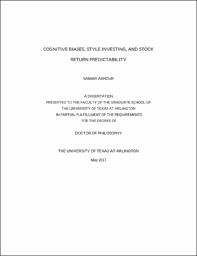
ATTENTION: The works hosted here are being migrated to a new repository that will consolidate resources, improve discoverability, and better show UTA's research impact on the global community. We will update authors as the migration progresses. Please see MavMatrix for more information.
Show simple item record
| dc.contributor.advisor | Hao, Grace (Qing) | |
| dc.creator | Ashour, Samar Mohamed M. | |
| dc.date.accessioned | 2019-07-09T21:39:47Z | |
| dc.date.available | 2019-07-09T21:39:47Z | |
| dc.date.created | 2017-05 | |
| dc.date.issued | 2017-04-28 | |
| dc.date.submitted | May 2017 | |
| dc.identifier.uri | http://hdl.handle.net/10106/28328 | |
| dc.description.abstract | This dissertation consists of three distinct essays. In the first essay, “Does Credit risk explain market’s participants ‘cognitive biases - Evidence from Anchoring Bias in Analysts’ Earnings Forecasts”, using anchoring bias in analysts’ earnings forecasts, I examine the relation between credit risk and market participants’ cognitive biases. Recent findings indicate that analysts suffer from anchoring bias as they anchor their earnings per share (EPS) forecasts on the industry median without making sufficient adjustment. I show that the profitability of anchoring bias based trading strategies concentrates in the worst-rated stocks, especially around credit rating downgrades, suggesting that analysts exhibit stronger cognitive biases when making earnings forecasts for firms with the greatest credit risk. Furthermore, I discover that credit risk can even explain the effect of anchoring on analysts’ forecast errors and future stock returns, highlighting the importance of credit risk for studies on market participants’ cognitive biases and stock market anomalies. My findings have broad implications for psychology-based asset pricing theory.
In the second essay, “Investor Sentiment and Style Investing”, I examine the implications of investor sentiment for style investing. I hypothesize that when investor sentiment is high, there are more style “switchers” who allocate funds based on a style’s relative past performance, leading to a stronger impact of style investing on asset prices. Consistent with my hypothesis, this study has two main findings. First, style returns have predictive power for future stock returns following high levels of sentiment but not low levels of sentiment. By focusing on the high-sentiment periods, style investing significantly affects the predictability of stock returns even during the early period of 1965-1987, and the significance of style investing increases during the later period of 1988-2014. Second, the correlation between past style returns and future stock returns can explain variation in momentum profits following high levels of sentiment but not low levels of sentiment. The profitability from the comovement-momentum based strategy under high sentiment is mainly driven by overpricing of losers socks due to short selling constraints. My findings highlight the important role of investor sentiment in pricing financial assets.
In the third essay, “Style Investing and IPO return predictability”, using a sample of 7,524 IPOs during 1975-2013, I find a strong evidence that an IPO stock’s past style returns can predict both IPO underpricing and post-IPO returns. I determine the style of each IPO stock based on its size and book-to-market ratio immediately after IPO. I find that IPO stocks’ past style returns are positively related to IPO underpricing and negatively related to post-IPO returns over 3-, 6-, and 12-month horizons. Moreover, the style return in the IPO month is negatively related to post-IPO returns up to three years. These findings underscore the empirical importance of style investing. | |
| dc.format.mimetype | application/pdf | |
| dc.language.iso | en_US | |
| dc.subject | Cognitive bias | |
| dc.subject | Anchoring bias | |
| dc.subject | Credit risk | |
| dc.subject | Style investing | |
| dc.subject | Sentiment | |
| dc.subject | IPOs | |
| dc.title | COGNITIVE BIASES, STYLE INVESTING, AND STOCK RETURN PREDICTABILITY | |
| dc.type | Thesis | |
| dc.degree.department | Finance | |
| dc.degree.name | Doctor of Philosophy in Finance | |
| dc.date.updated | 2019-07-09T21:39:47Z | |
| thesis.degree.department | Finance | |
| thesis.degree.grantor | The University of Texas at Arlington | |
| thesis.degree.level | Doctoral | |
| thesis.degree.name | Doctor of Philosophy in Finance | |
| dc.type.material | text | |
| dc.creator.orcid | 0000-0003-4845-5154 | |
Files in this item
- Name:
- ASHOUR-DISSERTATION-2017.pdf
- Size:
- 2.635Mb
- Format:
- PDF
This item appears in the following Collection(s)
Show simple item record


